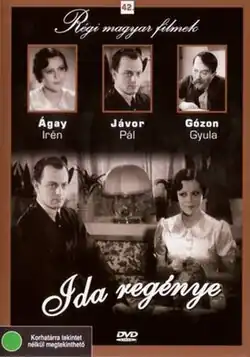Romance of Ida
| Romance of Ida | |
|---|---|
 | |
| Directed by | Steve Sekely |
| Written by |
|
| Produced by | Ernö Gál |
| Starring | |
| Cinematography | István Eiben |
| Edited by | József Szilas |
| Music by | Szabolcs Fényes |
Production company | Thalia-Film |
Release date |
|
Running time | 75 minutes |
| Country | Hungary |
| Language | Hungarian |
Romance of Ida (Hungarian: Ida regénye) is a 1934 Hungarian comedy film directed by Steve Sekely,[1] starring Gábor Rajnay, Irén Ágay, and Pál Jávor.[2] It is based on a novel by Géza Gárdonyi and was shot at the Hunnia Studios in Budapest. The film's sets were designed by the art director Márton Vincze.
The film is also referred to as My Wife the Miss.[1]
Cast
- Gábor Rajnay as Péter Ó
- Irén Ágay as Ida Ó
- Pál Jávor as János Balogh
- Ella Gombaszögi as Julis
- Gyula Gózon as Mr. Bogár
- Erzsi Paál as Ella
- Lili Berky as Abbess
- Sándor Pethes as Dr. Csorba
- Kató Eöry as Jolán
- Ida Turay as Fazekas
- Éva Fenyvessy as Housemaid
- Blanka Szombathelyi as Timár
- Annie Réthy as Mészkuthy
- Piri Peéry as Sister Ottilia
- Margit Ladomerszky as Sister Ladiszla
- Gerő Mály as Milkman
- Zoltán Makláry as Chauffeur
- Győző Zákányi as Máté
- László Dezsõffy as Theatre Director
- Böske T. Oláh as Wife of Theatre Director
- Erzsi Pártos as Ingenue
- Lajos Ihász as Leading Man
- Andor Sárossy as Butcher
- Ernő Király as Head Waiter
Production
The film was completed in just two weeks, and post-production took no longer than two months.[3]
Reception
The film was such a success at the time of its release that viewers even came from abroad. In addition to the name of the writer, the performances of Pál Jávor, Irén Ágay (the director's wife), and Szabolcs Fényes' song "Odavagyok magáért" (I'm Going for You), which immediately became a hit and played a significant role in this success[3]
Adaptations
- Romance of Ida, a 2022 Hungarian television film adaptation[4][5][3] is the third screen adaptation of the work. It follows two earlier versions, the main film and a 1974 TV version[6]
References
- ^ a b "Székely, István (1899–1979)". NFI. Retrieved 2025-06-24.
- ^ Bolton & Wright p.53
- ^ a b c Munkatársunktól (2025-05-24). "Zárdából a feslett táncoslányok és a bohém urak világába csöppent a tiszta szívű úrilány". Zárdából a feslett táncoslányok és a bohém urak világába csöppent a tiszta szívű úrilány (in Hungarian). Retrieved 2025-06-24.
- ^ "Ida Regénye – Premis Zoom". Retrieved 2025-06-24.
- ^ "Ida regénye". TVGuide.com. Retrieved 2025-06-24.
- ^ "A szerelem ostobaság, de gyönyörű ostobaság". filmhu - a magyar moziportál. Retrieved 2025-06-24.
Bibliography
- Bolton, Lucy & Wright Julie Lobalzo (ed.) Lasting Screen Stars: Images that Fade and Personas that Endure. Springer, 2016.
External links